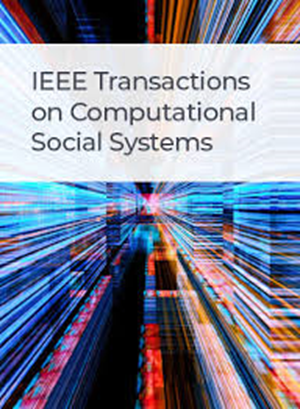Traffic Origin-Destination Demand Prediction via Multichannel Hypergraph Convolutional Networks
IF 4.5
2区 计算机科学
Q1 COMPUTER SCIENCE, CYBERNETICS
IEEE Transactions on Computational Social Systems
Pub Date : 2024-03-29
DOI:10.1109/TCSS.2024.3372856
引用次数: 0
Abstract
Accurate prediction of origin-destination (OD) demand is critical for service providers to efficiently allocate limited resources in regions with high travel demands. However, OD distributions pose significant challenges, characterized by high sparsity, complex spatial correlations within regions or chains, and potential repetition due to the recurrence of similar semantic contexts. These challenges impede traditional graph-based approaches, which connect two vertices through an edge, from performing effectively in OD prediction. Thus, we present a novel multichannel hypergraph convolutional neural network (MC-HGCN) to overcome the above challenges. The model innovatively extracts distinctive features from the channels of inflows, outflows, and OD flows, to conquer the high sparsity in OD matrices. High-order spatial proximity within regions and OD chains are then modeled by the three adjacency hypergraphs constructed for the above three channels. In each adjacency hypergraph, multiple neighboring stations are treated as vertices, while multiple OD pairs constitute hyperedges. These structures are learned by hypergraph convolutional networks for latent spatial correlations. On this basis, a semantic hypergraph is created for the OD channel to model OD distributions lacking spatial proximity but sharing semantic correlations. It utilizes hyperedges to represent semantic correlations among OD pairs whose origins and destinations both possess similar point-of-interest (POI) functions, before learned by a hypergraph convolutional network (HGCN). Both spatial and semantic correlations intrinsic to OD flows are accordingly captured and embedded into a gated recurrent unit (GRU) to unveil hidden spatiotemporal dependencies among OD distributions. These embedded correlations are ultimately integrated through a multichannel fusion module to enhance the prediction of OD flows, even for minor ones. Our model is validated through experiments on three public datasets, demonstrating its robust performances across long and short time steps. Findings may contribute theoretical insights for practical applications, such as coordinating traffic scheduling or route planning.通过多通道超图卷积网络预测交通起源-目的地需求
准确预测出发地-目的地(OD)需求对于服务提供商在旅行需求旺盛的地区有效分配有限资源至关重要。然而,出发地-目的地分布具有高度稀疏性、区域或链条内复杂的空间相关性,以及由于类似语义上下文的重复出现而可能造成的重复等特点,给预测带来了巨大挑战。这些挑战阻碍了传统的基于图的方法(通过边连接两个顶点)在 OD 预测中有效发挥作用。因此,我们提出了一种新型多通道超图卷积神经网络(MC-HGCN)来克服上述挑战。该模型创新性地从流入、流出和外径流量的通道中提取出独特的特征,以克服外径矩阵的高稀疏性。然后,通过为上述三个渠道构建的三个邻接超图来模拟区域和 OD 链内的高阶空间邻近性。在每个邻接超图中,多个相邻站点被视为顶点,而多个 OD 对构成超门。这些结构通过超图卷积网络学习潜在的空间相关性。在此基础上,为 OD 信道创建了语义超图,以模拟缺乏空间邻近性但共享语义相关性的 OD 分布。在超图卷积网络(HGCN)学习之前,它利用超桥来表示起源和目的地都具有类似兴趣点(POI)功能的 OD 对之间的语义相关性。因此,OD 流量固有的空间和语义相关性被捕获并嵌入到门控递归单元(GRU)中,以揭示 OD 分布之间隐藏的时空相关性。这些嵌入的相关性最终会通过多通道融合模块进行整合,以增强对 OD 流量的预测,即使是次要的 OD 流量。我们的模型通过在三个公共数据集上的实验进行了验证,证明了其在长短时间步长上的稳健表现。研究结果可为协调交通调度或路线规划等实际应用提供理论见解。
本文章由计算机程序翻译,如有差异,请以英文原文为准。
求助全文
约1分钟内获得全文
求助全文
来源期刊

IEEE Transactions on Computational Social Systems
Social Sciences-Social Sciences (miscellaneous)
CiteScore
10.00
自引率
20.00%
发文量
316
期刊介绍:
IEEE Transactions on Computational Social Systems focuses on such topics as modeling, simulation, analysis and understanding of social systems from the quantitative and/or computational perspective. "Systems" include man-man, man-machine and machine-machine organizations and adversarial situations as well as social media structures and their dynamics. More specifically, the proposed transactions publishes articles on modeling the dynamics of social systems, methodologies for incorporating and representing socio-cultural and behavioral aspects in computational modeling, analysis of social system behavior and structure, and paradigms for social systems modeling and simulation. The journal also features articles on social network dynamics, social intelligence and cognition, social systems design and architectures, socio-cultural modeling and representation, and computational behavior modeling, and their applications.
文献相关原料
| 公司名称 | 产品信息 | 采购帮参考价格 |
|---|
 求助内容:
求助内容: 应助结果提醒方式:
应助结果提醒方式:


